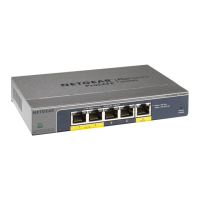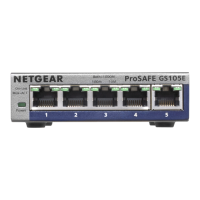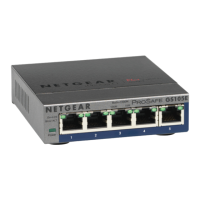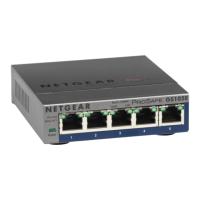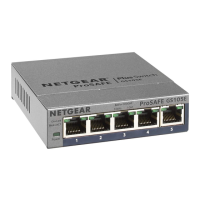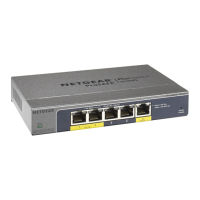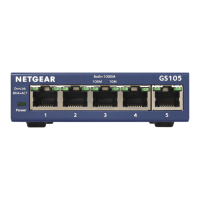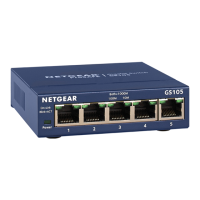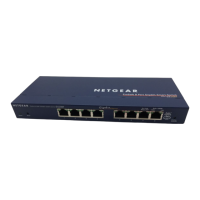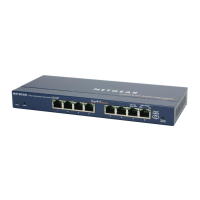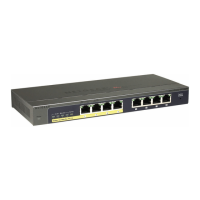Do you have a question about the NETGEAR GS105Ev2 and is the answer not in the manual?
Lists all supported Gigabit Ethernet Smart Managed Plus switch models.
Provides guidelines to ensure personal safety and protect the system from damage.
Explains how to set up the switch for basic operation.
Details how to access the switch's local browser interface.
Guides on accessing the switch when connected to a network via DHCP.
Provides instructions for accessing the switch when not connected to a network.
Explains how to use the ProSAFE Plus Utility to access the switch.
Step-by-step guide to install the ProSAFE Plus Utility.
Instructions for using the Switch Discovery Tool to find and access the switch.
How to use the mobile app to discover and access the switch.
Steps to change the default switch password for security.
How to change the language of the browser interface for most switches.
Method to change language for specific models via firmware update.
Instructions for registering the NETGEAR product for support.
Explains Virtual LANs and how ports are grouped.
Guides on assigning ports to virtual networks in basic VLAN configuration.
How to assign a single port to multiple VLANs for advanced configuration.
Steps to create 802.1Q VLANs with basic configuration.
How to create 802.1Q VLANs with tagged/untagged ports and PVID.
Instructions for assigning tagged or untagged ports to an 802.1Q VLAN.
How to assign a Port VLAN ID (PVID) to data packets.
How to enable QoS based on 802.1p or DSCP tagging for packet prioritization.
Assigns priority to data based on the port for faster transmission.
Limits the rate of incoming and outgoing data for ports.
Configures the switch to block broadcast storms and manage traffic.
Explains default IP addressing and how to set static IP addresses.
How to use a web browser to set the switch's IP address.
Using the utility to configure the switch IP address.
How IGMP snooping intelligently forwards multicast traffic.
Steps to customize IGMP snooping settings for network optimization.
How to specify a VLAN for IGMP snooping.
How to combine multiple Ethernet links into a single logical link for increased reliability.
How to enable or disable IEEE 802.3x flow control to manage congestion.
How to set port speed, auto-negotiation, or disable ports.
How to enable loop detection to identify and indicate network loops.
How to manage power saving features like EEE and link-down power saving.
Instructions to download and install the latest firmware for the switch.
How to remotely reboot the switch.
How to save the current switch configuration to a file.
Steps to restore a previously saved switch configuration.
How to reset the switch to its original factory default settings.
How to control which devices can access the switch via web browser.
Steps to add IP addresses to the access control table.
How to remove devices from the access control table, disabling access control.
How to mirror traffic from source ports to a destination port for analysis.
How to view switch details and change its network name.
How to view and reset port statistics like bytes received/sent and CRC errors.
Explains PoE power prioritization and allocation based on port order.
Uses a cable diagnostic feature to check network cable health and fault locations.
Steps to resolve IP subnet conflicts when accessing the switch.
Tips for troubleshooting common Power over Ethernet (PoE) issues.
Lists all supported Gigabit Ethernet Smart Managed Plus switch models.
Provides guidelines to ensure personal safety and protect the system from damage.
Explains how to set up the switch for basic operation.
Details how to access the switch's local browser interface.
Guides on accessing the switch when connected to a network via DHCP.
Provides instructions for accessing the switch when not connected to a network.
Explains how to use the ProSAFE Plus Utility to access the switch.
Step-by-step guide to install the ProSAFE Plus Utility.
Instructions for using the Switch Discovery Tool to find and access the switch.
How to use the mobile app to discover and access the switch.
Steps to change the default switch password for security.
How to change the language of the browser interface for most switches.
Method to change language for specific models via firmware update.
Instructions for registering the NETGEAR product for support.
Explains Virtual LANs and how ports are grouped.
Guides on assigning ports to virtual networks in basic VLAN configuration.
How to assign a single port to multiple VLANs for advanced configuration.
Steps to create 802.1Q VLANs with basic configuration.
How to create 802.1Q VLANs with tagged/untagged ports and PVID.
Instructions for assigning tagged or untagged ports to an 802.1Q VLAN.
How to assign a Port VLAN ID (PVID) to data packets.
How to enable QoS based on 802.1p or DSCP tagging for packet prioritization.
Assigns priority to data based on the port for faster transmission.
Limits the rate of incoming and outgoing data for ports.
Configures the switch to block broadcast storms and manage traffic.
Explains default IP addressing and how to set static IP addresses.
How to use a web browser to set the switch's IP address.
Using the utility to configure the switch IP address.
How IGMP snooping intelligently forwards multicast traffic.
Steps to customize IGMP snooping settings for network optimization.
How to specify a VLAN for IGMP snooping.
How to combine multiple Ethernet links into a single logical link for increased reliability.
How to enable or disable IEEE 802.3x flow control to manage congestion.
How to set port speed, auto-negotiation, or disable ports.
How to enable loop detection to identify and indicate network loops.
How to manage power saving features like EEE and link-down power saving.
Instructions to download and install the latest firmware for the switch.
How to remotely reboot the switch.
How to save the current switch configuration to a file.
Steps to restore a previously saved switch configuration.
How to reset the switch to its original factory default settings.
How to control which devices can access the switch via web browser.
Steps to add IP addresses to the access control table.
How to remove devices from the access control table, disabling access control.
How to mirror traffic from source ports to a destination port for analysis.
How to view switch details and change its network name.
How to view and reset port statistics like bytes received/sent and CRC errors.
Explains PoE power prioritization and allocation based on port order.
Uses a cable diagnostic feature to check network cable health and fault locations.
Steps to resolve IP subnet conflicts when accessing the switch.
Tips for troubleshooting common Power over Ethernet (PoE) issues.
| Model | GS105Ev2 |
|---|---|
| Category | Switch |
| Ports | 5 |
| Switching Capacity | 10 Gbps |
| Forwarding Rate | 7.4 Mpps |
| VLAN Support | Yes |
| Quality of Service (QoS) | Yes |
| Energy Efficient Ethernet (EEE) | Yes |
| Power Supply | External Power Adapter |
| Storage Temperature | -20° to 70° C (-4° to 158° F) |
| Operating Temperature | 0°C to 40°C |
| Humidity | 90% maximum relative humidity, noncondensing |
| Standards Compliance | IEEE 802.3, IEEE 802.3u, IEEE 802.3az |
| Dimensions | 6.22 x 4.02 x 1.10 in (158 x 102 x 28 mm) |
| Weight | 0.24 kg (0.53 lb) |
| Jumbo Frame Support | Yes |
